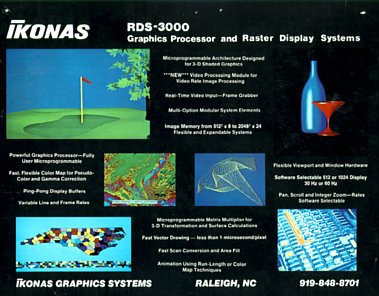|
|
|
Manifest Technology Blog
-- Site:
| Articles
| Galleries
| Resources
| DVI Tech
| About
| Site Map
|
DVI Technology:
| Chronology
| Products
| Applications
| Galactic Challenge
| Publications
| Photos & Videos
|
Ikonas Graphics Systems
by Nick England, Ikonas Founder
"From our first Ikonas system delivered in
November 1981,
this remarkably powerful and flexible machine
was a major part of our success in communicating the vision of DVI,
and nurturing it until the chips arrived in December 1987."
- Douglas Dixon. Communications of the ACM, July
1989.
 Nick England and Mary Whitton in the Ikonas historical booth at SIGGRAPH '98
(photo by D. Dixon)
Nick England and Mary Whitton in the Ikonas historical booth at SIGGRAPH '98
(photo by D. Dixon)
(Local copy - originally post at UNC, www.cs.unc.edu/~nick/ikonas.html,
now see www.virhistory.com/ikonas/ikonas.html)

History - Ikonas Graphics Systems Inc. was founded in 1978 by Mary Whitton and me, based on work I
did as a grad student at North Carolina State University in the Computer Graphics Lab
headed by Prof. John Staudhammer.
As part of a project funded by NASA Langley Research
Center, I had developed a programmable raster display system for cockpit instrumentation
display. (see my paper in SIGGRAPH 78). Several people expressed interest in acquiring
something similar so Mary and I started Ikonas to make a commercial version.
Architecture - Ikonas concentrated on developing flexible, programmable, high end graphics and imaging
hardware for research groups. The system was based around a 32 bit data, 24 bit address
bus into which various boards could be plugged. Everything within the sytem was memory
mapped into this 24 bit address space. A host interface was provided with address
registers to access anything on the bus.
Major elements of the Ikonas system were a flexible frame buffer for display and a
micro-programmable processor for performing graphics and imaging functions. The frame
buffer resolution and timing could be set via control registers. The processor included 32
bit integer ALU and 16x16 bit integer multiplier along with address counters, loop
counters and the like, all controlled by a 64 bit instruction word.
Other plug-in boards developed during the lifetime of the system include:
- 16 bit graphics processor with parallel pixel write
- microprogrammed 16x16 bit matrix multiplier
- microprogrammed floating point matrix multiplier
- hardware Z-buffer
- alpha-blend hardware for two RGB images
- 68000 processor with hard disk running UNIX(tm)
- real-time RGB video frame grabber
- interfaces to DEC, Data General, and a bunch more computers

We developed a great deal of microcode, covering 3-D graphics, image processing, seismic
data display, flight simulation, ray tracing, and solid modelling.
Customers got a microcode compiler (and later, several C compilers were available) and
were strongly encouraged (!) to develop their own code. They came up with all sorts of
interesting and imaginative ways to use the system. Ikonas gear was used for the
"Genesis Planet Sequence" in Star Trek:The Wrath of Khan, for the video games in
Superman III and for a bunch of TV commercials, as well as for a lot of serious scientific
and engineering work.
From "Life Before the Chips: Simulating Digital Video Interactive Technology" by
Douglas F. Dixon. Communications of the ACM, July 1989, pp 824-831.
"From our first Ikonas system delivered in November 1981, this remarkably powerful
and flexible machine was a major part of our success in communicating the vision of
DVI,
and nurturing it until the chips arrived in December 1987. Some of that flexibility and
power also lives on in its influence on the design of the DVI chip set. The more
expressive the simulation environment for a product concept, the more ideas can be
explored and prototyped for the final design, and the more likely that features of the
simulation system become incorporated in the product."
From "Hardware Support for Multitasking Graphics" by William Cowan, Christopher
Wein, Marcelli Wein, Kellogg S. Booth. Graphics Interface '91 proceedings, June 1991, pp
199-206.
"Finally, it is interesting to note that the interface construction discussed in this
paper and the further enhancements discussed in this last section are easy to carry out in
the [Ikonas] RDS-3000, a decade old design. Its flexibility, modularity, and openness make
it possible to design and substitute components in a way that cannot be done with newer
designs offering higher graphics performance at the cost of closed hardware. Systems like
the RDS-3000 may be unsuitable for the production graphics that makes up the vast bulk of
the market, but they are the life blood of laboratories that conduct research into new
techniques for combining computation and graphics."
For some more info on the system, see an article I wrote in the January 1986 IEEE Computer
Graphics and Applications magazine. Also see Tim Van Hook's SIGGRAPH 86 paper covering
some amazing real-time solid modeling microcode he wrote for the Ikonas.
Ikonas was acquired by Adage Inc in 1982 and the Ikonas system continued to be marketed as
the Adage 3000 Raster Display System. I'd guess almost 400 systems were sold before Adage
finally pulled the plug around 1987. Some are evidently still in use after more than 10
years, a minor miracle in the computer business.
There were lots of great people who were part of Ikonas and we had lots of great (and
patient) customers. Thanks for the wonderful experience.
Nick England
|

